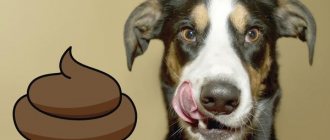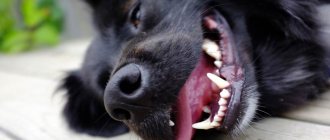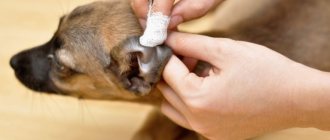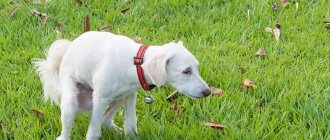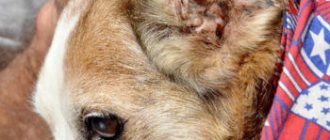It may be disgusting, smelly, and unpleasant, but the color of your dog's poop can tell a lot of stories about your pet. It can tell you what it ate and even if your canine friend suffers from a certain disease or not. This is why fecal testing is often a routine procedure in many veterinary laboratory and diagnostic tests, as it can reveal a lot about what is going on inside your pet's body. So, what does the color of dog poop actually mean?
Journey through the dog's digestive tract
Since we're talking about feces, which is technically the end result of a physiological process known as digestion, we need to take a close look at the path of any given type of food through the gastrointestinal tract, since the color of a dog's poop depends on what happens somewhere along the way.
The digestive tract is a very long tube that starts in the mouth and ends in the anus. This is a contiguous tract, and between the esophagus and the duodenum of the small intestine there will be only one major outlet, forming a pouch-like structure known as the stomach.
When food enters a dog's mouth, it travels down the esophagus and into the stomach, where a whole bunch of stomach fluids try to chug, digest, and break down all the different food molecules into smaller pieces in preparation for final digestion and absorption in the small intestine. The food then passes through the duodenum—the first section of the small intestine—where it is filled with juices from the liver, gallbladder, and pancreas to ensure that all macromolecules of the food's nutrients are properly digested for absorption.
© shutterstock
The gallbladder secretes bile, a greenish substance that facilitates the processing of fat by various digestive enzymes. There are other enzymes and digestive fluids from the pancreas and liver, each of which adds additional color to the food. Food passes the entire length of the small intestine—the jejunum and the cecum—until it reaches the large intestine. By this time, water and other substances are constantly being reabsorbed by the body, forming a harder mass that we now call stool or feces. When nature demands, this stool is passed through the rectum and exits the anus.
Symptoms of certain diseases
We found out why a dog might have black feces. Now you have to deal with additional symptoms of some diseases.
Let's take worms. A dog infected with them is lethargic. Her eyes are cloudy, the pet refuses to walk and play. But the appetite is just crazy. The dog eats everything he sees. She is constantly hungry. What should the owner do? Buy deworming tablets and give them to your dog.
Viral enteritis. This is an infectious disease, and you can protect your puppy from it by getting vaccinated. Just remember: vaccination is not a panacea for all ills. It is also important to comply with the conditions of content. For example, the dog is fed correctly, and has a separate place for rest. It started snowing, and the owners were walking with the puppy at that time. And they walked for a long time. The baby is wet and his immune system is weakened. And hello, enteritis.
How does it manifest itself, besides the fact that the dog has black stool? The animal vomits, the feces are speckled with blood clots. The dog is lethargic and lies all the time. She may have seizures. Refuses to eat and drink.
What measures should the owner take? We remember that infection very quickly destroys the puppy. Therefore, you need to urgently call a veterinarian. Treatment is usually carried out at home. This is the placement of IVs. The sooner treatment begins, the higher the pet's chances of survival.
In case of gastric bleeding, the owner’s best decision would be to call a veterinarian.
If a foreign object gets into your pet’s gastrointestinal tract, know that the condition worsens very quickly. Don't hesitate to visit a veterinarian.
Brown and well formed
This is generally considered a normal stool color in dogs. The brownish tint occurs due to the yellowing of bilirubin, a substance present in bile. This is the same substance that gives skin a slightly brownish to pinkish hue. Do not confuse this with jaundice, as this is due to increased bilirubin in the bloodstream. As long as your dog's brown stool doesn't show any additional colors, such as streaks of red or yellow, you should be happy that your pet is fine. In addition, it must be correctly formed. It may be brown, but if it is more watery than usual, that is also abnormal.
Yellow diarrhea in a puppy, as a normal option
For the first days after birth, puppies eat exclusively colostrum. In the first month of life, puppies' diet consists only of milk. During this period, yellow stools with a soft consistency are normal.
With normal microflora in a newborn puppy, colostrum is digested within several hours. Usually, the mother licks the puppies, and the owner does not know what color their stool is. However, if one of the puppies is stunted or weak, the dog does not have enough milk, or other circumstances arise for the introduction of supplementary food, the owner may be confused.
From birth to one month of age, diarrhea in puppies is defined as bowel movements more than 6 times a day. Diarrhea is also diagnosed if the stool becomes watery or downright liquid. Normally, the stool of a one-month-old puppy has a distinct yellow color and a viscous consistency.
Diarrhea in puppies aged from birth to one month can occur for three main reasons: dysbacteriosis, overeating or allergies. Dysbacteriosis very often develops in puppies that are bottle-fed or have not received colostrum.
Red or brown with red veins
Any reddish color to a dog's stool always indicates active bleeding in the lower gastrointestinal tract, usually limited to the large intestine, rectum, or even the internal structures of the anus. This is different from bleeding in the small intestine because this structure is actually several feet long. To give you an idea, a dog's small intestine alone can be 2.5 times the length of your dog's body. So if your dog's body length is around 50cm, you can expect his small intestine to be around 100cm in length. If the bleeding occurs anywhere in the duodenum, the time it takes to reach the rectum and anus will be long enough for it to harden or thicken. Since you see bright red streaks, the bleeding is occurring in the cecum or the colon itself. Other causes could be colitis, a colon tumor, a parasitic infection, or even an infection of the anal glands.
Possible causes of yellow feces in dogs
The dog has black poop: causes of dark poop
Yellow stool in a dog can occur due to the following factors:
- improper feeding and food preparation. The cause of problems is the use of low-quality or expired feed. Also, the appearance of yellow liquid stool in a dog is caused by the use of spoiled foods;
- deviations in the diet, while the dog does not receive the required elements;
- excess lipids in the diet;
- allergic reactions to the ingredients of ready-made food or components of natural food;
- systemic lesions of the digestive organs;
There are many causes of yellow stool
- foreign objects that have entered the stomach or intestines;
- severe damage to the intestinal walls or digestive organs by helminths. The provoking factor is dirofilariasis;
- pathologies of the hepatobiliary system, congenital and acquired;
- inflammatory processes in the digestive organs;
- viral, bacterial and fungal infections;
- intoxication with chemical or toxic substances.
For your information! Yellow poop in dogs is due to excessive intestinal motility. In this case, the bile secretion enters the duodenum and includes bilirubin.
Black or resinous
This is the opposite of the color of a dog's stool, which has bright red streaks. Black or tarry stool is always a sign of upper gastrointestinal bleeding, such as from a stomach or duodenal ulcer. Given the exceptional length of the small intestine, blood in the stool will take significantly longer to solidify. By the time it passes through the rectum and anus, it will already be significantly curled up and you will no longer see the red spots. One of the leading causes of upper gastrointestinal bleeding in dogs is the consumption of certain medications, such as aspirin. Therefore, it is important to always consult with your veterinarian about the medications you plan to give your dog.
Causes of yellow diarrhea in dogs
Yellow feces in a dog are a clear sign of pathology. Under normal conditions, dog feces are dark brown in color and well formed. The basic sign of indigestion is the occurrence of profuse diarrhea.
Diarrhea is the process of frequent bowel movements, with watery, mushy or tarry stools. Feces discharged from the rectum may contain foam, mucus, blood fractions or particles of undigested food.
There are several types of diarrhea in dogs - acute and chronic. The latter type of diarrhea is characterized by a long course - from several days to 2 weeks.
Yellow diarrhea in a dog can develop as a result of exposure to the following factors:
- problems with diet – lack of substances necessary for the body;
- violation of feeding and food preparation rules (poor quality, expired food, spoiled food);
- high amount of lipids in the diet;
- inflammation processes in the digestive system;
- a sharp change in the dog’s diet and feeding regime;
- food allergy to one of the components of ready-made food or products included in natural food;
- foreign bodies stuck in the stomach or intestines;
- serious damage to the intestinal walls and digestive system by helminths;
- diseases of a congenital and acquired nature in the hepatobiliary system;
- infectious diseases of viral, bacterial or fungal etiology;
- intoxication with chemical and toxic substances;
- systemic disorders of the gastrointestinal tract.
The appearance of yellow diarrhea is often noted with increased peristalsis of the walls of the small and large intestines. Bile secretion enters the duodenum and contains bilirubin.
Under normal operating conditions of the digestive system, bilirubin is processed, turning into urobilin and stercobilin. Urobilin turns urine yellow, and stercobilin gives stool a brown tint.
With the development of diarrhea, the motility of the intestinal walls increases significantly, and bilirubin does not have time to undergo changes. The stool turns yellow and sometimes orange.
If your dog has yellow stool, the cause may be hepatic or extrahepatic jaundice. This is due to the fact that bilirubin does not transform into other particles, is excreted into the lumen of the large intestine, and colors the feces in a bright yellow or orange hue. In this case, the watery consistency of the excreted portion of feces is noted.
In addition to changes in the color of feces during jaundice, the color of visible mucous membranes and skin changes, nausea and vomiting in dogs are noted.
The cause of bright yellow saturated color of feces in dogs can be a malignant neoplasm in the pancreas, chronic hepatosis, cirrhosis of the liver, inflammatory processes in the pancreas, malfunctions of the liver while taking certain medications, and disturbances in the functioning of the gallbladder. Yellow diarrhea is observed in pets with bile duct obstruction.
Factors that provoke the appearance of yellow stool in a dog can be helminthiasis. Serious helminthic infestations (nematodes, cestodes, liver fluke infection) affect not only the liver structures and intestinal walls, but also gradually poison the animal’s body with the products of its metabolism.
Yellow stool occurs in animals due to eating too fatty foods. This phenomenon is especially often diagnosed in pets that often receive “treats” from the human table. Acute diarrhea occurs after consuming various sausages, sausages and dishes rich in vegetable oil.
The appearance of a strong odor from feces against a yellow background indicates the presence of an infection in the body - parvovirus or coronavirus enteritis, distemper, salmonellosis. The appearance of diarrhea is noted at the very first stages of the processes of inflammation and decay in the body.
If you find yellow diarrhea with blood in your pet, you must immediately show the animal to a professional. Such symptoms indicate the development of dangerous intestinal infections, the presence of foreign bodies stuck in the intestines. Problems with stool are caused by salmonellosis, E. coli or streptococcal infection.
Toy dog breeds, especially puppies, react sensitively to components added to industrial feed. Thus, yellow diarrhea can occur in a miniature dog as a result of low quality food, a large amount of aromatic substances, lipids and stabilizers.
Other factors that provoke problems in the digestive system are emotional overload, frequent stress conditions of the animal, and food allergies. Diarrhea in an animal is also provoked by increased sensitivity to certain components in medications or feed.
Rarely, but sometimes dogs develop yellow diarrhea during routine immunization a couple of days after the vaccine is administered.
Stool upset is also observed with long-term use of antimicrobial agents. This is due to the ability of antibiotics to inhibit beneficial intestinal microflora, provoking the development of dysbiosis.
White and chalky or brown with white speckles
If you see white specks in your dog's feces, these could be the eggs of certain intestinal parasites that have passed through the feces. However, if your dog's feces are whitish in color or perhaps even look chalky, then there is a high chance that your dog may be suffering from hypercalcemia, or a condition in which excessive amounts of calcium are released into the bloodstream. This can occur with bone fractures or any other type of bone injury because the calcium released by the bone matrix must be reabsorbed into the bloodstream.
© shutterstock
Purple or pink
If you see what looks like raspberry jam in your dog's stool or that there is an unusual amount of blood passing through your pet's rectum and anus, this is often a sign of hemorrhagic gastroenteritis, or severe bleeding caused by inflammation of the small and large intestines. If you notice this type of feces on your dog, be sure to seek emergency veterinary care immediately. You must understand that thousands of dogs die every year due to hemorrhagic gastroenteritis, which can lead to massive blood loss, electrolyte imbalance, tissue hypoxia and death. However, with timely treatment, your dog can prevent disaster.
Grey
Remember what we said about how the brown color of dog stool is a function of bilirubin found in bile acids? Well, if there is not enough bilirubin or bile salts, your dog's feces will appear pale or grayish in color. Because bile salts are produced in the liver and stored in the gallbladder, the absence of bilirubin or bile salts in the stool may mean there is a problem in the liver or gallbladder. However, the most common culprit is an obstruction of the common duct, which is where the ducts from the liver, pancreas and gallbladder meet as they go to the duodenum, which drains fluids and enzymes. In such cases, if an obstruction is suspected, surgery to remove the obstruction may be required.
White feces are a symptom of an unhealthy pet.
Every person, even those who do not have a pet, probably knows what the normal color of dog feces should be.
If the animal is healthy, then its feces are dark or moderately light brown. This color comes from bile, a vital fluid produced by the liver. By the way, scientifically, white feces are called acholic. When the liver or gallbladder is not in order, the dog may suffer from loss of appetite (especially the dog is literally sick of fatty foods), intestinal problems (sometimes diarrhea, frequent constipation), nausea and vomiting, flatulence, belching, spasmodic pain in the peritoneum, lethargy , sometimes temperature. It is because of problems with the production of bile that, as a rule, the dog’s feces are white, but the urine may be darker than usual. Also, with such illnesses, the skin, mucous membranes, and sclera of the eyes turn yellow.
What diseases specifically can provoke the formation of colorless feces? Most often, the following ailments lead to this problem:
- Gallstone disease
is the presence of sand or stones in the gallbladder or its ducts; - Oncological tumors of the liver or gallbladder
are malignant neoplasms that cause many disturbances in the functioning of the entire body, including distortion of the normal outflow of bile; - Liver cirrhosis
is the irreversible replacement of healthy liver tissue with fibrous tissue; - Cholangitis
is inflammation of the gallbladder and its ducts; - Hepatitis
– liver inflammation; - Cholangiohepatitis
is a simultaneous inflammation of the bile ducts and the liver itself; - Cysts in the liver
are benign formations that interfere with the normal functioning of the organ; - Deformation of the bile ducts
is a congenital or acquired change in the normal shape or size of the gallbladder; - In some situations, white feces are caused by an inflamed canine pancreas (pancreatitis)
.
Green
If you notice that your dog's poop has taken on a greenish tint, there's a good chance that he just likes your grassy lawn. Dogs are known to eat grass, especially if they have an upset stomach. So don't be surprised if you see greenish poop on your dog. Unfortunately, eating grass is not the only reason why your dog's poop may turn green. In some cases, this may be due to rat bait poisoning, a parasitic infection, or other gastrointestinal problems. The only thing you can do to identify grass-related green poop is to look for telltale signs of undigested grass or leaves. If you can't find one, then you'd better take your dog to the vet.
Diarrhea in dogs as a physiological feature
It's all about the characteristics of the gastrointestinal tract of dogs:
- The length of the intestines in dogs is relatively short. Any “disturbance” is enough for the digestion process to be disrupted.
- For the same reason, a very meager set of symbiotic microflora is collected in the gastrointestinal tract of dogs. It dies quickly, which is why the digestion process is immediately disrupted.
In addition, there is one more nuance that many breeders forget about. The point is that dogs are not the most sophisticated gourmets.
Firstly, they often pick up rotten and even downright rotten food on the street, and this needs to be monitored (not only banal diarrhea is possible, but also poisoning).
Secondly, dogs especially do not need a very varied diet. Moreover, even a one-time sharp change in diet practically guarantees the dog severe and prolonged diarrhea, since its gastrointestinal tract is not at all different in its quick adaptability.
Thus, when feeding your pet you need to follow a couple of simple but extremely important rules:
- The less frequently your diet changes, the better. We recommend feeding dogs aged five years and older with high-quality, balanced food. If this is not possible, you need to consult a veterinarian and create a normal, high-quality and balanced diet. Practice shows that in this case dogs not only vilify much less often, but also live on average three years longer.
- Dogs may benefit from giving probiotics from time to time. We recommend using drugs in liquid form, as they have a more pronounced effect. Many experienced breeders recommend regular kefir and other fermented milk products in small quantities for these purposes. Practice shows that they are not much inferior in effectiveness to “famous” commercial products.
Orange
You might think that yellowish colored dog stool is a sign that they ate too much carrots or pumpkin, but in fact it is a possible indication of gallbladder or liver problems. There may be too much bilirubin in the stool, causing it to appear more orange than normal brown. However, most often, orange-colored stools are watery, reminiscent of diarrhea. Therefore, if you see stool of this color in your dog, it is best to consult a veterinarian.
Yellow
If you notice a yellowish-orange color in your dog's stool, there is a chance that it is due to bile duct or liver problems, as we mentioned above. The only way to be sure of a possible connection with liver or biliary problems is to compare it with other clinical data. For example, if you also notice yellowing of your dog's conjunctiva, as well as the mucous membranes of the eyelids and the inside of the lips, then there is a possibility of liver disease, possibly hepatitis. This leads to an abnormal accumulation of freely circulating bilirubin in the blood, which eventually ends up in the stool, giving it a bright yellow or orange hue.
© shutterstock
However, if yellowing of the stool cannot be confirmed by other clinical signs, and the stool itself is quite watery or slimy, you may be dealing with a food intolerance. Again, you must correlate this with other manifestations, as food intolerance in dogs almost always manifests itself as vomiting and abdominal pain.
What to do if your dog has white stool
We have listed the main reasons why a dog has white feces.
But what should an owner do if, while walking, he suddenly saw that instead of the usual brown “sausage,” his pet “produced” whitish fecal matter? First, you need to put aside your panic and observe your dog’s stool for 1-3 days. Perhaps the dog made a pile of an unusual color by eating something wrong (a bone, several fatty pork cutlets, etc.). If after a day or three the color of the stool continues to be whitish, and the dog’s condition is causing concern, you will have to take the animal to the clinic.
To prescribe the correct treatment, the specialist will have to conduct a number of studies:
- To assess the condition of the liver and to identify inflammatory processes, you will need to undergo general urine and blood tests (biochemistry may also be needed);
- To determine the condition of the animal’s pancreas, a biochemical urine test will be taken, as well as a stool test;
- If you suspect a cyst or tumor in the liver or pancreas, as well as stones in the gall bladder, an ultrasound of the peritoneum will be required;
- The doctor may do an X-ray to get information about the size of the liver;
- In some cases, a liver biopsy will not be necessary to make a diagnosis.
As we mentioned just above, white, hard feces are a good reason to visit a veterinarian. And especially if the animal feels unwell (vomiting, bloating and abdominal pain, etc.). The dog will most likely be prescribed antibiotic therapy (Trichopol, Cephalexin), choleretic agents (Allohol, Holosas), hepatoprotectors (Hepatoject, Hepatovet), antispasmodics and painkillers (No-Shpa, Baralgin, Butorphanol), enzymes (Mezim, Creon) and others medications, the use of which may be required depending on the condition of the animal. And in some situations, the only salvation for your pet will be surgery (for example, with a cyst in the liver or a tumor of the gallbladder).
Greyish with a greasy appearance
If your dog's stool is slightly grayish in color and really slimy, oily, or greasy, then your dog may have exocrine pancreatic insufficiency. They call it exocrine to distinguish it from the endocrine function of the pancreas, which is mainly its ability to produce and secrete insulin and glucagon to regulate the metabolism of carbohydrates and other substances in the body. The exocrine function of the pancreas is directly related to its ability to produce and secrete digestive enzymes such as lipases, amylases, and proteases, which digest fats, carbohydrates, and proteins, respectively.
We mentioned above that as food passes through the duodenum, it fills with fluids from the liver, gallbladder and pancreas. The gallbladder secretes bile salts into food so that the fat in food can be adequately coated. This makes them relatively easy to digest by pancreatic lipases. If there is a problem in either of these two mechanisms, or even both, then the fat contained in food is not digested properly and is not absorbed into the blood. Instead, these fats will pass through the intestines, rectum, and anus, causing oily or greasy stool.
Some of the most common conditions that can cause exocrine pancreatic insufficiency in dogs can include pancreatic cancer, cystic fibrosis, and even chronic pancreatitis. If the underlying problem is the release of bile salts, then possible causes may include gallstone formation and extensive liver damage.
Other potential canine conditions that can cause steatorrhea—fatty feces—include intestinal malabsorption secondary to giardiasis, inflammatory bowel disease, overgrowth or harmful bacteria, and even celiac disease, although the latter condition is very rare in dogs.
Ensuring “normal” stool color
Feeding your dog a quality diet should help prevent any fecal problems. Limiting your intake of human foods can also promote healthier digestion, even if these foods are generally considered safe. Keeping your home and premises free of trash, compost piles, parasites, vermin and other harmful objects, organisms and chemicals should also be an integral part of the best pet care. However, you should also keep your medications out of reach of pets.
The color of a dog's stool can tell us a lot about its feeding habits and how its body actually reacts to the substances it puts in its mouth. It is our responsibility as pet parents to understand these stool colors and what they really mean so we can know what to do next.
Author of the article : Olivia Williams.
